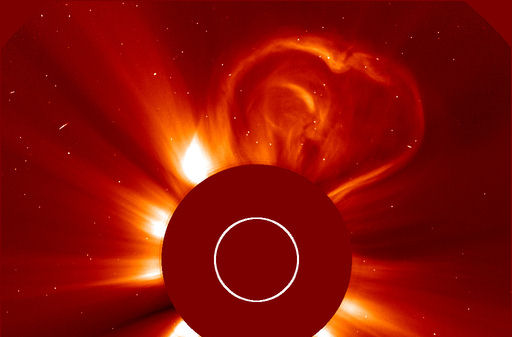SUNSET PLANETS: For the second day in a row, Venus and the crescent Moon are shining together in the sunset sky. Look west at the end of the day for a beautiful view. New images: #1, #2, #3, #4, #5, #6, #7, #8, #9, #10, #11, #12.
MORE SOLAR ACTIVITY: Sunspot AR1402, the source of this week's powerful M9-class solar flare, is acting up again. On Jan. 26th between 0100 UT and 0600 UT, a sequence of C-class magnetic eruptions around the active region hurled a bright coronal mass ejection over the sun's north pole, shown here in a coronagraph image from the Solar and Heliospheric Observatory:
The cloud is not heading toward Earth, at least not directly. This and future eruptions from AR1402 are unlikely to be geoeffective as the sunspot is turning away from our planet. By week's end it will be on the far side of the sun, blasting its CMEs toward planets on the opposite side of the solar system.

![]()
Solar wind
speed: 457.3 km/sec
density: 0.6 protons/cm3
explanation | more data
Updated: Today at 1446 UT
![]()
X-ray Solar Flares
6-hr max: C2 1011 UT Jan26
24-hr: C7 0149 UT Jan26
explanation | more data
Updated: Today at: 1400 UT
![]()
![]()
![]()
Daily Sun: 26 Jan 12
![]()
![]()
A new sunspot is emerging at the circled location. Credit: SDO/HMI
![]()
![]()
![]()
Sunspot number: 68
What is the sunspot number?
Updated 25 Jan 2012
Spotless Days
Current Stretch: 0 days
2012 total: 0 days (0%)
2011 total: 2 days (<1%)
2010 total: 51 days (14%)
2009 total: 260 days (71%)
Since 2004: 821 days
Typical Solar Min: 486 days
Updated 25 Jan 2012
The Radio Sun
10.7 cm flux: 126 sfu
explanation | more data
Updated 25 Jan 2012
![]()
![]()
![]()
Current Auroral Oval:
![]()
Switch to: Europe, USA, New Zealand, Antarctica
Credit: NOAA/POES
![]()
![]()
![]()
Planetary K-index
Now: Kp= 2 quiet
24-hr max: Kp= 2 quiet
explanation | more data
![]()
Interplanetary Mag. Field
Btotal: 6.4 nT
Bz: 6 nT south
explanation | more data
Updated: Today at 1447 UT
![]()
![]()
![]()
Coronal Holes: 26 Jan 12
![]()
![]()
Solar wind flowing from the indicated coronal hole should reach Earth on Jan. 28-29. Credit: SDO/AIA.





